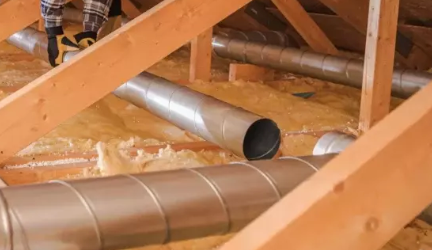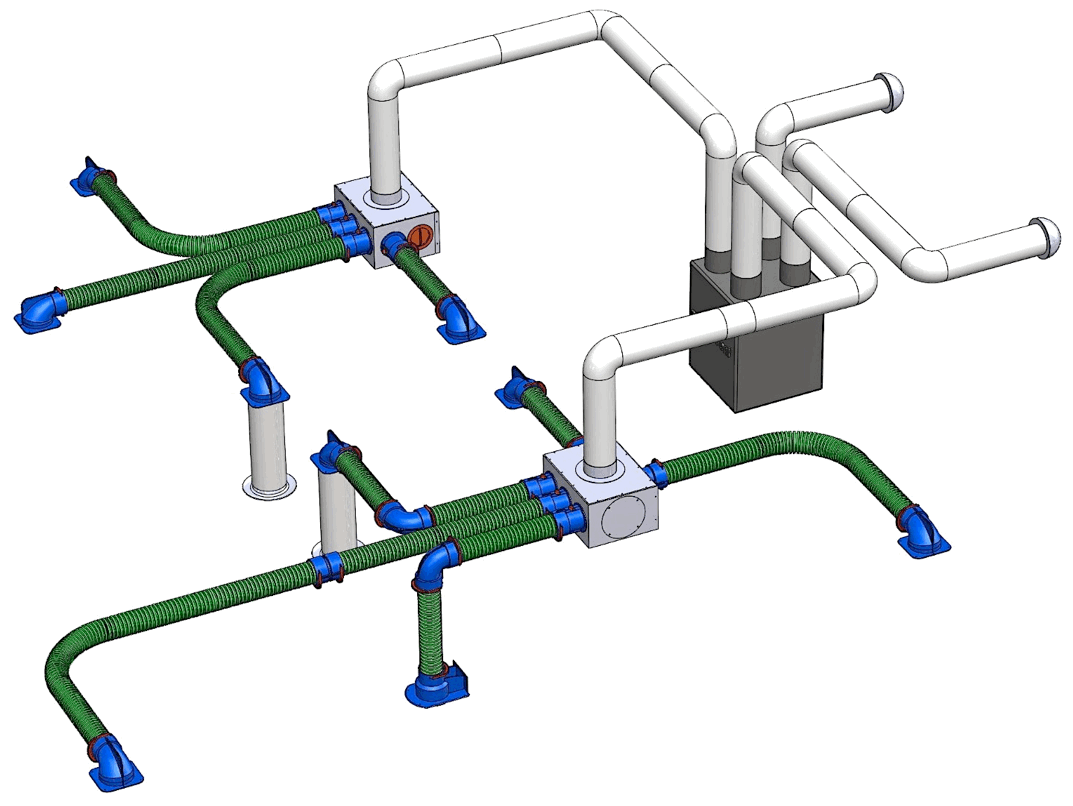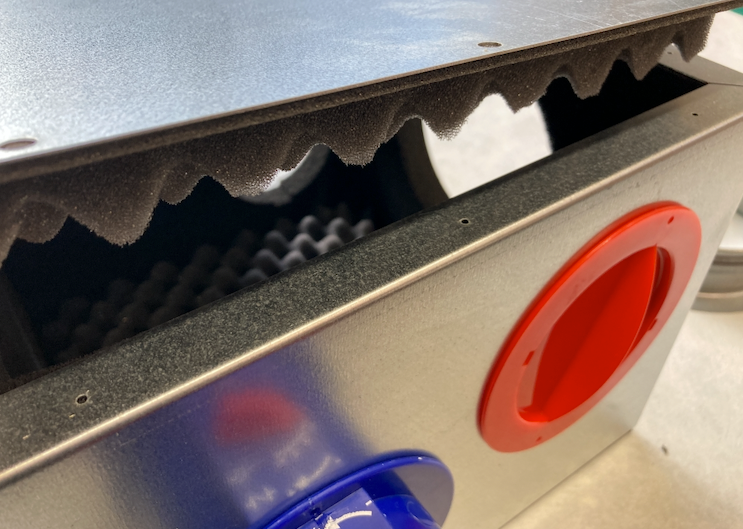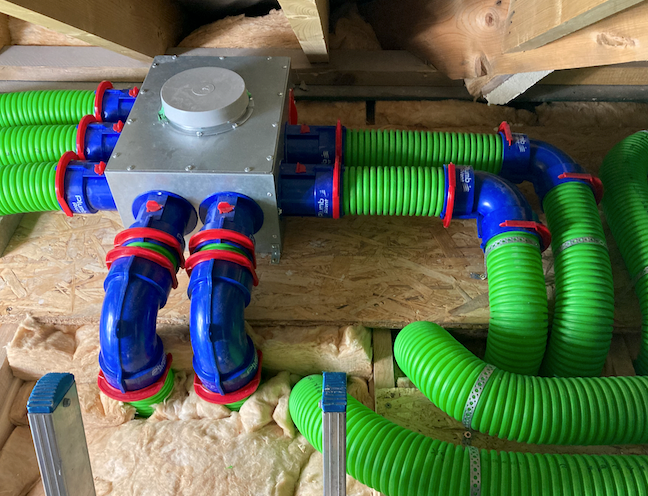My path to find the best ventilation system
This is my journey in the world of ventilation for my home some 20 years ago and now is my business selling and sharing information with home owners and anyone that cares to listen. As an Engineer, Designer, Building contractor and now Ventilation installer this is my thought process on ventilation systems for your home.
💡 This is why it is important
According to the World Health Organisation Ref 1
- Household air pollution exposure leads to diseases including stroke, heart disease, chronic obstructive pulmonary disease (COPD) and lung cancer.
Indoor Air quality is important
Why? we are not designed to live indoors, as mammals. We build shelters to live in to keep us warm and dry, but when we seal these shelters up to stop fresh air coming in - now we have a problem.
Yes you can open a window
Yes we can knock holes in the walls
Yes we can open doors
But we dont!!

😍 Ideally Co2 level at 400PPM is desirable, this is the approximate outdoor level. Co2 level is used as a indicator of freshness albeit there are many other factors which influence our air quality.
ref-2
So thats the reason- now the journey.
As an Engineer and a building contractor when it came to building my own house 20 year ago the system of ventilation was to build in 100 mm holes in each room or use slot vents in each window. WHY was I going to spend all my money on insulation and good windows and then knock holes in the wall. It did not make sence. There must be a better way??
Information gathering
Ok so we knew it did not make sence, so we went on the quest for other approaches to ventilation. At a trade show we came across a Danish company selling ventilation machines which remove the bad air and replace it with exterior air. Not only that, the machine uses the outgoing air to heat the incoming air. Brilliant, so by using a small amount of electricity we can control the air we breath and save money on heat losses.
So how did it work out?
What can I say but perfect, fresh air in the house all the time, no condensation in the bathrooms, no cooking smells. Yes just change the filters each year, thats all we did for 20 years.
This is only part of our journey
Selecting the air ductwork system
Well what choices do we have?:
- Spiral metal ducting with trunk and branch.
- Plastic ducting in the form of 125 diameter and 150 diameter or flat equivalent.
- Semi rigid ducting in a radial system.
Pros:
- Spiral metal is very solid and durable
- Can be part of the architectural aspect if left exposed.
- Plastic 125mm and 150 mm is cheap to install.
- It is easy to work with
- Fitting are relatively easy to source.
- Semi rigid ducting is in exceptional easy to work with.
- Is very durable and flexible.
- Fittings are easy to use.
Cons:
- Difficult to cut needing grinding tools.
- Can create a drum effect and requiring additional silencers.
- Not very strong and can lead to crushing.
- Sealing mastic, glue or tapes needed to join.
- Susceptible to mould growth on the interior.
- The 50 meter coils of ducting need uncoiling.
So what did I use in my house?
Well -- None of the above, probably because I ran out of time researching and trying to get into our house with a young family.
I used a form of insulated flexible ductwork on a trunk and branch system.

It worked but, I would not recommend it and does not meet any of our new regulations. It is very susceptible to crushing. Now we would only use this for very short connections in ventilation install.
As a building contractor, building homes and extension for clients I would always recommend installing a ventilation system. In which case we would install a Genvex machine with metal spiral ducting to each room. Slow to install and costly. We did it for years.

We then used plastic ducting, It was cost effective and relatively fast to install, but it was difficult to seal properly. It is not tested for use in a ventilation system.

Then a new type of ducting emerged, Semi rigid ducting in either 75mm or 90mm diameter. It was certified and tested to be equal or better that spiral metal ducting. It was fast to install, solid and relatively easy fittings to use.
Now we are onto something! A air duct that is strong durable easily used and fitted into the building structure, not requiring specialist tools. And a protected smooth inner layer with anti fungal properties.
This is what we have being using going forward.
So this is what we used moving forward.
We used various suppliers for our different construction projects, they were just ok. The product itself was ok but it could be designed better.
So I set about designing fitting and a complete system that clicks together and is easy to set up with the correct air flow to each room.
Some of the problems solved.
Adjusting the correct airflow to each room is critical when balancing the system. Suppliers were using a couple of systems namely adjusting the ceiling vent cover. This creates a problem in that the pressure in the duct is high and by restricting the flow at the ceiling valve can cause noise.

Another method is pop out rings to allow certain amount of air to move through the duct, but this cannot be adjusted.

So I designed a method of adjusting the flow at the manifold with a simple thumb turn valve.
This was developed in conjunction with the distribution manifold. This was designed in different formats, 6 port, 8port, 10 port but they all have the same thing in common. They all use the manifold connector for connection to the ductwork. They have a 45% reduction in acoustic transmission with the inclusion of sound dampening material so they act as silencers in the system.
We then developed other fittings to complete our full ducting system.
The ceiling plenum was next for our design.

Designed by us using our experiences as installers, it incorporates may fixing points. The flange for the 125 ceiling cover can fit directly over the plasterboard or can be extended up to 600mm with 125mm diameter ducting as in the picture below. the unit also incorporates air straightening vanes to allow minimum disruption to air flow, but will still allow cleaning in the future.
The S90 Bend is a simple fitting to allow for direction change of the semi rigid ducting. Although the ducting is very flexible sometimes we need to do a 90degree bend without stain.

This fitting allows very small pressure loss due again to flow straightening vanes within the fitting. This is something that other manufactures cannot achieved do to our manufacturing processes.
A one minute video on ventilation ducting install
Testing and Certification
This stage of testing was important, The certification body is the British Research Establishment BRE.
The test involves the testing of all ventilation equipment and Ducting for use in ventilation installations. The standard used is one of comparison to Spiral metal ducting. A successful result will allow the product to be included on the PCDB which is a data base of all tested products. This in turn allows a listing on SAP appendix Q data base which means that the product can be identified for BER listing.
The result obtained was categorised as being equal and equal to spiral metal ducting.
Well how does it work?
As an Installer?
Perfect, easy to install and it works. Simple to balance and commission, quiet in operation.
Well what else would I say?? One of the benefits of being the designer and manufacturer is that if it needs to be changed or adapted we do it. So it has been refined to a point now where it is in our option and other installers a great Ventilation ducting system.
As a self builder?
As one person said it is " Like Lego" just clicks together and "It Works"
We supply all the part needed for a full system either in kit form in various sizes or a fully specified supply, if you send us your drawings in PDF.
As a Consumer of clean warm fresh air?
Happy, we think so. Its not until you live in a house with our system do you understand the difference in air quality. Yes, its feels fresh and all the nice things. Its only when you go into your friends house or visit someones house you realise they have bad air it feels unhealthy. Difficult to put your finger on it, but this is your body telling you its not good.
Having good air quality in your own home is taken for granted as it has always been this way in your home.
Have a look at some of our reviews.
Last Thoughts
If you are building or renovating your home, keep this in mind.
Spend as much time and money on Insulation and airtightness.
Then --
Ventilation
Then --
Heating.
In that order.
This is how you build for a modern, efficient, clean air house. The air your family breath is important for their health and wellbeing.
Dont take my word for it, this is what Harvard magazine said about it.
You live longer in a clean air home.
Links
Ref 1 https://www.who.int/news-room/fact-sheets/detail/household-air-pollution-and-health
Ref 2 https://www.ncbi.nlm.nih.gov/pmc/articles/PMC7411428/
Ref 3
https://www.harvardmagazine.com/2009/05/clean-air-longer-life#:~:text=When%20it%20comes%20to%20personal,the%20longer%20you%20will%20live.











